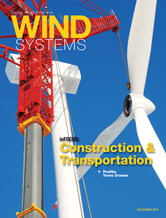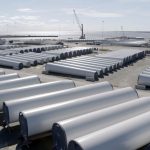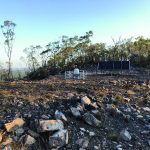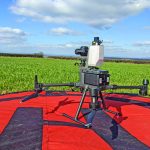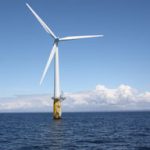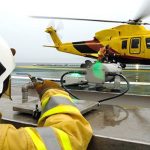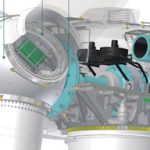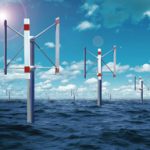Using wind to create clean, renewable energy is a noble goal. It’s also a goal that’s quickly becoming more economical and profitable. But in order to make the power, nature has to make enough wind.
Wind is abundant around the world, but it’s not everywhere around the world. Unfortunately, this simple geographical fact has kept many areas from taking advantage of this clean-energy production method.
SheerWind in Minnesota has a solution to the no-wind scenario. Its patented Invelox system overcomes the problem by creating useable wind in areas where traditional turbines are ineffective.
The L-shaped Invelox — short for Increased Velocity — looks like Dr. Seuss dreamed it up for Whoville’s town square, but it’s that unique geometry that brings wind power to wind-starved areas.
“Rather than putting turbines where the wind blows enough to turn them, we are controlling the wind and increasing its speed, and then putting the turbines in that area where we’ve increased the speed,” said Carla Scholz, chief marketing and communications officer with SheerWind.
How it works
Wind is captured at the top of Invelox’s funnel. Depending on power needs, the funnel can be anywhere from 26 feet to more than 720 feet high. The funnel is open on all sides, so wind can be captured from any direction. As the wind is funneled through the system, it is concentrated and accelerated.
That wind — now made faster as it flows through a narrower corridor — flows across up to three ground-based turbines that convert the artificially accelerated air into electricity.
Finally, that air enters a diffuser, which slows the wind and returns it back to nature.
“It’s very much like a hydro dam,” Scholz said. “Because we’re just squeezing that air just like they squeeze water.”
The real beauty of the Invelox system is that it can be installed just about anywhere, she said.
“The current wind technology has to go into wind corridors,” Scholz said. “That’s where the birds are flying. And that becomes an issue. What we’re finding now is putting them where nothing else will work is our sweet spot.”
Palmyra Atoll
As an example, Scholz points out the Nature Conservancy’s wildlife research island at the Palmyra Atoll overseen by the U.S. Fish and Wildlife Service.
The Atoll, about 1,000 miles southwest of Honolulu, is home to more than a million protected nesting birds. The facility there was running primarily on diesel fuel. It had installed some solar, but it wasn’t generating the needed power, according to Scholz.
“They could not use a traditional wind-turbine system for two major reasons: No. 1, it wouldn’t turn,” she said. “Because even though it’s out in the middle of the Pacific, their wind speeds are not great. Which is surprising. Apparently, there isn’t wind everywhere in the ocean like we all think there is.”
The second major reason was to protect the island’s wildlife.
“They said, ‘No way, you can’t put up any kind of turbine; it’s not gonna happen,’” Scholz said. “Not to mention, that it probably would have been taken out in a few days by the number of birds.”
The Invelox system doesn’t have the potential adverse effect on birds, but as an added safety precaution, the system at Palmyra Atoll had nets installed over the intake and outtake areas, according to Scholz.
“There’s a net that can actually protect birds from flying in from any direction,” she said. “However, we have our model in Chaska, Minnesota, and it’s been here now for nearly five years, and we’ve never had any issues with birds.”
Michigan National Guard
Since all government facilities have been mandated to find ways to use renewable energy, the Michigan National Guard also has been able to benefit from the Invelox system.
“There’s no wind to speak of in Michigan,” Scholz said. “It’s just one of those places where there’s not a lot of wind.”
The Army Guard facility tried solar panels, but they weren’t getting the job done. And even if there was decent sustainable wind, a wind farm near a military base can create its own set of unique problems.
“You can essentially fly a drone or something through a wind farm undetected because the radar interference is so great,” Scholz said. “That’s the reason the Michigan Army National Guard was willing to take a chance and help us figure this out. And working together, they’ve been fabulous to work with because they’re in a hard spot, and we really want to help them.”
The guard unit now uses three Invelox units, and two more are nearing construction completion. They are expected to be operational sometime in 2017, according to Scholz.
Many of the concerns associated with large wind turbines also are eliminated with the Invelox system.
“Our blades are 60-percent smaller,” Scholz said. “And it’s also ground based, so you don’t have to be a professional climber to work around our turbines.”
Low-frequency noise and blade flicker also are eliminated, according to Scholz.
Blending In
The unusual shape of the Invelox system definitely catches the eye, but for businesses that think it might be too “out there,” there’s a solution.
“As long as the geometry of the Invelox stays the same on the inside, you can put any structure around the outside,” Scholz said.
The critical intake and outtake of the Invelox have to remain unobstructed. “(But) they could essentially look like anything,” she said.
Invelox has been operating since 2012, when the pilot program went online at Sheerwind’s Minnesota headquarters.
Since then, SheerWind operates through distribution hubs, according to Scholz.
“We’ve gone that route so we can get our technology out around the globe faster, with the idea that you can basically build the funnel out of anything that we say will work,” she said. “We’ve used fiberglass and steel and plastic. So, that way (a hub) can engineer based on our IP.”
The Invelox system has the potential to bring wind power to areas that simply could not support it before.
It’s scalable across the wind-industry spectrum, and it can be used anywhere from community-sized settings to major wind farms.
The concept is simple, according to Scholz. But the science and engineering behind Invelox is anything but.



















